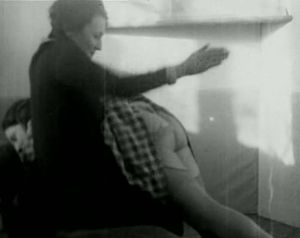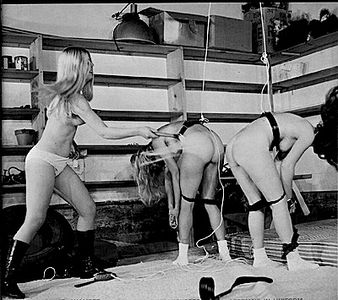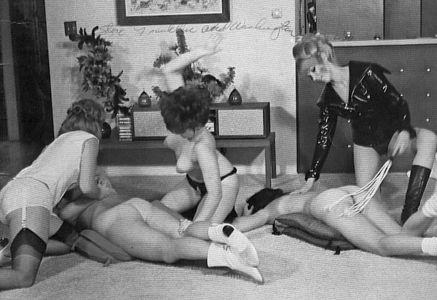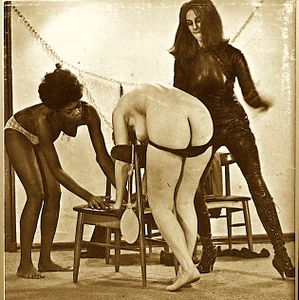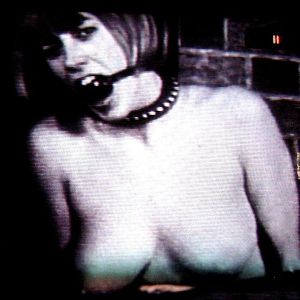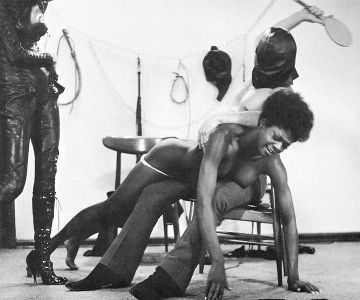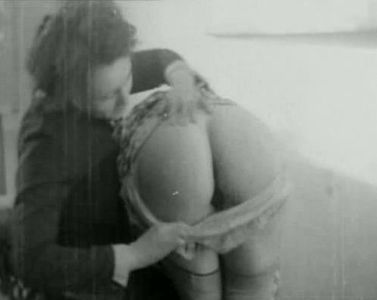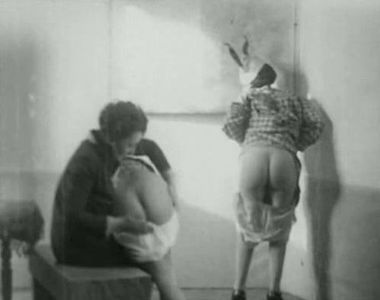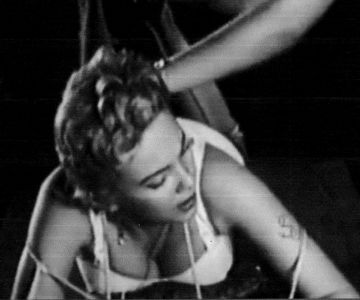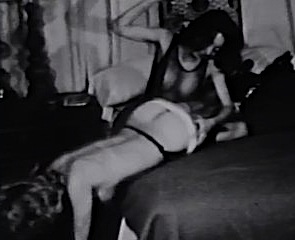Stag film
[[]]
A Stag film, stag reel or stag party film is an erotic, often explicitly pornographic, film reel produced from the 1900s to the early 1980s. The term stag refers to single men ("to go stag" = "to go alone"). Some pornographic shorts made in the 1930s even had a fictitious "Stag Films" company logo showing the head of a male deer. These "blue movies" were originally shown in brothels, fraternal organizations and social clubs (hence the term "smokers"), private all-male parties (especially bachelor parties), as well as "members only" cinema clubs. (For more details, see The early years.)
Stag reels (aka film-loops) were initially highly illicit and nearly always produced anonymously for fear of legal prosecution. These "nudies" were primarily clandestine 8mm and 16mm silent, single-reel short films (5 to 15 minutes in length) made for private viewing and sold under the counter at adult book shops.
By the early 1950s, nonpornographic reels featuring nudism, striptease acts, and various fetishes (bondage, spanking, role-play, etc.), were being sold through mail order ads placed in mainstream girlie publications and underground fetish/spanking magazines (Bizarre, Corporal, et al.). Cheap film projectors and hand-held viewers were also sold through men's magazines. In the late 1960s an 8mm fetish reel 200 feet in length sold for around $20-$25.
Fetish-oriented reels generally did not contain sex acts (or even nudity in many cases) while pornographic sex reels did not include fetishistic content. (Some films produced in France starting in the 1930s are the exception.) By the seventies, color films, some with audio music tracks, were introduced as the line between hardcore pornography and non-sex fetish reels began to blur.
Stag reels produced on film became obsolete in the early eighties with the introduction of the videocassette and VCR home-viewing technology. Many of the earliest bondage/spanking videotapes were compilations of silent 8mm stag reels converted to Beta/VHS format, often with public domain music added to the soundtrack.
Spanking in stag reels
The earliest stag reels with fetish and BDSM sexuality come primarily from France in the 1930s (later, other countries followed). Several Paris-produced spanking/whipping reels still exist, including some by erotic/fetish photographer Biederer Brothers (Biederer Studio, Ostra Studio).
The 1950s
Irving Klaw is the most well-known producer of underground film-loops in the fifties, many of which star fetish icon Bettie Page. His all-female featurettes, while containing no sex or nudity (for legal reasons), ran the gamut of kinky fantasies from foot fetishism to female wrestling, elaborate bondage, and spanking-domination scenarios.
Throughout the decade, fetish loops avoided nudity. Women were seen cavorting in various undergarments or leather ensembles, including fetish-friendly stockings, garter belts, and high heels. These precautions (along with the exclusion of male performers) were taken to avoid being classified as pornography which, at that time, could not be sent through the mail.
The introduction of inexpensive, good-quality 8mm projectors in the late-fifties created a home-movie boom. Individuals could now acquire stag films for private viewing or men-only parties. Camera stores began stocking a few reels of stag films for rental to special customers.
The 1960s
The mid-to-late sixties saw a sharp increase in the production of bondage-spanking loops (the popular Super 8 camera was introduced in 1965) that were far more provocative due to less-stringent obscenity laws in the U.S. and Europe. Unlike the past, these films freely exploited nudity – but, like the men's magazines of the time, avoided full-frontal exposure.
The by-now-antiquated loops of the Irving Klaw era were mostly shot on simple sets with careful stage lighting and a static, tripod-mounted camera. By contrast, the sixties loops have a casual, home-movie style with practical locations (living rooms, bed rooms, basements, etc.), mobile hand-held cameras, and little regard for lighting and framing. The typical scenario involves pretty, topless women wearing bikini briefs and heels/go-go boots engaging in cat-fights and light bondage, culminating in a round-robin of energetic group spanking administered by hand, hairbrush, paddle, and flogger.
Most of the fetish reels from this period that have been preserved on DVD came out of the New York and Los Angeles underground. However, according to "The History of Sex in Cinema" (Playboy, November 1967), Britain was the largest foreign supplier of stag material in the U.S. And in particular, films featuring sadomasochistic activity (spanking, whipping, etc.). Many of these reels were disguised with French titles for marketing and/or legal reasons. Stag films, along with other pornographic materials, were sold on a relatively open basis in hole-in-the-wall London bookshops in the Soho area.
London photographer Harrison Marks established himself as a brand-name producer of loops, girlie photos, and even feature-length "nudie cutie" exploitation films. Starting in 1960, Marks directed scores of "glamour" stag films (buxom nude models in simple vignettes). With the loops Perchance to Scream (1967), The Lash, and Macabre (both 1968), he began exploring whipping, spanking, and other BDSM themes followed by a much-banned, barely released fetish-heavy exploitation film Pattern of Evil, aka Fornicon (1968).
The 1970s and beyond
The last wave of stag films in the seventies introduced color film, limited audio (usually just music), and much harsher, more explicit content. Now competing with X-rated feature films shown in theaters, loops began to specialize in a stronger, more realistic blend of sex and sadism.
Starting in 1976, Classic Fetish Films (Tao Productions, Hollywood, Calif.) was one of the first magazines based entirely on stills from kink-specific stag reels. It featured color and black-and-white photos of spanking, bondage, cat fights, enemas, etc.
Production companies began to come out from behind the cloak of anonymity. California-based House of Milan and Nu-West/Leda Productions promoted their brand and became well-known leaders in the industry. In the early eighties they were among the first to make the transition from 8mm spanking/BDSM loops to VHS/Beta mini-features (30 to 60 minutes long) released on videocassette. Nu-West also released compilations of its early silent 8mm loops on videotape.
At the same time in England, Harrison Marks and others were producing Super 8mm loops (mostly with a uniformed schoolgirl caning theme) which were advertised in British spanking magazines such as Janus, Roué, and Kane. Marks turned to directing full-length spanking videos in 1987.
See also
- Polissons et galipettes, made from French silent stag reels made between 1905 and 1930, also featuring some spanking
- Pornography
- Spanking film
- Spanking in mainstream films
Chat rooms • What links here • Copyright info • Contact information • Category:Root
